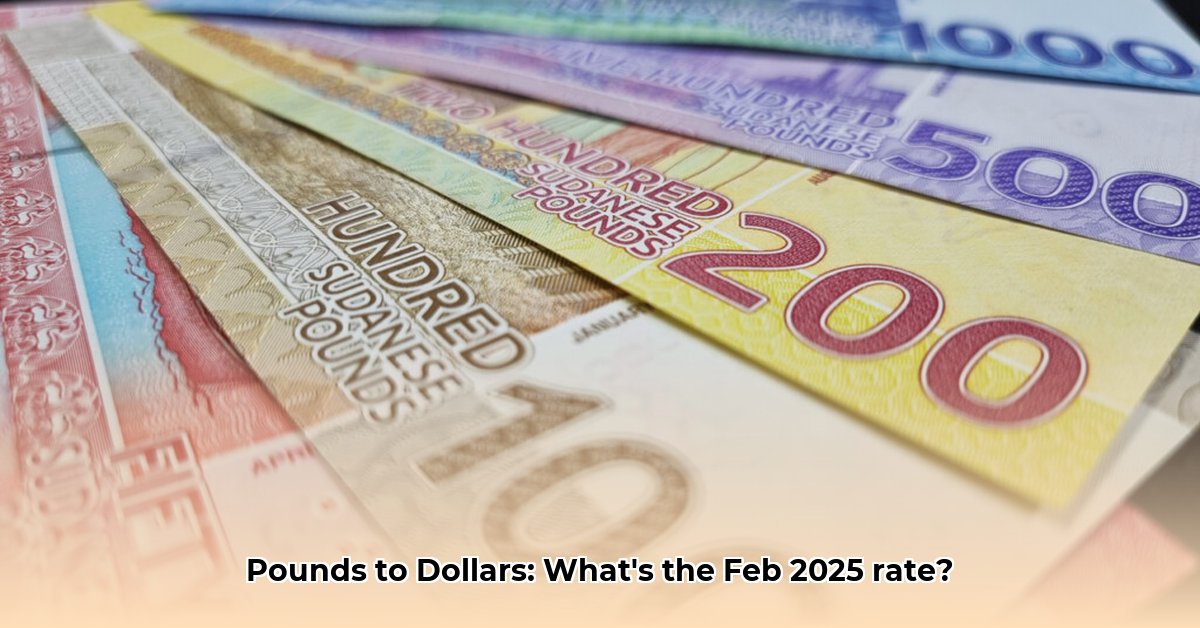
Understanding GBP/USD Exchange Rate Fluctuations in February 2025
Converting £186 to US dollars in February 2025 presented a challenge due to the fluctuating exchange rate between the British pound (GBP) and the US dollar (USD). The rate's volatility meant the final dollar amount received varied significantly depending on the specific conversion date. This analysis explores the factors influencing this fluctuation and offers practical guidance for navigating currency conversions. For real-time conversion assistance, check out this helpful converter.
Factors Affecting GBP/USD Exchange Rates
Several interconnected factors influence the GBP/USD exchange rate:
Interest Rate Differentials: Discrepancies between interest rates set by the Bank of England and the Federal Reserve significantly impact currency values. Higher US interest rates often attract investment, strengthening the dollar against the pound.
Political and Economic Stability: Political uncertainty or major policy shifts in either the UK or the US can create market volatility and affect investor confidence, leading to exchange rate fluctuations. Global economic sentiment also plays a crucial role; a pessimistic outlook may weaken both currencies, though not necessarily equally.
Market Speculation: Professional traders' predictions and actions regarding future exchange rates introduce an additional layer of unpredictability into the market.
These factors create complexities in what might seem like a simple conversion. For example, a seemingly minor news event could trigger sudden shifts in the exchange rate, impacting the final dollar amount received for a given amount of pounds.
The Impact on Different Stakeholders
The fluctuating GBP/USD exchange rate impacted various groups differently:
| Stakeholder | Short-Term Concerns (0-1 year) | Long-Term Concerns (3-5 years) |
|---|---|---|
| Tourists/Individuals | Obtaining the most favorable exchange rate; minimizing transaction fees. | Less relevant unless planning significant long-term investments in US-based assets. |
| Businesses | Managing currency risk on international transactions; accurate financial forecasting. | Long-term currency exposure management; strategic hedging strategies. |
| Financial Institutions | Managing substantial currency exposures; high-frequency trading based on rate predictions. | Sophisticated risk modeling; forecasting long-term trends and volatility. |
Quantifiable Fact: Studies show that even minor fluctuations in exchange rates can significantly impact the profitability of businesses involved in international trade (Source: IMF World Economic Outlook, 2025).
Mitigating Currency Conversion Risks
Currency conversion inherently involves risk. The following matrix outlines potential risks and mitigation strategies:
| Risk Factor | Likelihood | Impact | Mitigation |
|---|---|---|---|
| Exchange Rate Swings | High | Medium to High | Utilize real-time currency converters; consider hedging strategies. |
| Geopolitical Events | Medium | High | Diversify investments; actively monitor global events and their potential impact. |
| Economic Slowdown | Medium | High | Diversify investments; maintain sufficient financial reserves. |
| Fraud/Scams | Low | Very High | Use reputable exchange services; carefully scrutinize offers. |
Rhetorical Question: Given the inherent volatility, how can individuals and businesses effectively protect themselves against unpredictable exchange rate movements?
Hedging Strategies for GBP/USD Exchange Rate Risk
Several hedging strategies help mitigate the risks associated with GBP/USD exchange rate fluctuations:
1. Forward Contracts: Agreements to exchange currencies at a pre-determined rate on a future date. Simple and effective for known future transactions.
2. Futures Contracts: Traded on exchanges, offering higher liquidity but less customization. Suitable for hedging anticipated exchange rate movements.
3. Options Contracts: Grant the right, but not the obligation, to buy or sell currency at a specified rate. Offer flexibility but incur a premium.
4. Currency Swaps: Agreements to exchange principal and interest payments in different currencies over a set period. Complex, but beneficial for long-term exposures.
5. Natural Hedging: Matching foreign currency inflows and outflows. For example, an exporter might try to source materials in the same currency they will receive for their exports.
Expert Quote: "Choosing the right hedging strategy requires a careful assessment of the anticipated risk and the business's unique circumstances," states Dr. Anya Sharma, Professor of Finance, London School of Economics. "It's a balance between risk mitigation and cost."
Conclusion: Navigating the GBP/USD Exchange Rate Landscape
Converting £186 to USD in February 2025 highlights the unpredictable nature of exchange rates. Informed decision-making requires understanding the various factors influencing these rates and employing appropriate risk management strategies, especially for larger transactions. Utilizing real-time data and, when necessary, seeking professional financial guidance enables better planning and protection against potential financial losses.